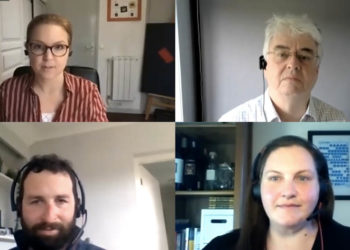Over the past year, since the pandemic’s earliest days, a cascade of in-person conferences were canceled or turned into virtual events. The sudden virtualization of conferences has sparked a flurry of experimentation.
Earlier this month, Alice Meadows wrote about PIDapalooza, a “24-hour virtual PID party, starting at 9.30am EST on January 27 and ending at 10.30am on January 28 (yes, it was actually 25 hours in the end, but who’s counting!?). We had… 92 back-to-back half-hour sessions and over 130 speakers…, with one track, two tracks, even three tracks at times — to enable sessions in Portuguese, Spanish, Chinese, Japanese, German, and French, as well as English.” We are impressed — and exhausted — to hear about the possibilities when maximizing toward openness and inclusivity, but we also note other approaches, such as the one described by Mark Carden as he has virtualized the Researcher to Reader conference while trying to retain its intimacy and interactivity.
Conferences serve several roles. They offer faculty and researchers a way to showcase their work through presentations. They connect people through formal and informal interactions, including serendipitous hallway conversations. Some offer professional development. Most bring together exhibitors (people who have things to sell) and attendees (people who have things to buy). And of course conferences serve their organizers as a way to bring the field together as well as, for some, a source of revenue-generation. In some cases, they are a unique opportunity to bring together “everyone” in a field. In other cases, they offer a small and intimate chance for deeper engagement.
At Ithaka S+R, we are preparing to launch a cohort-based strategic analysis of the future of the academic conference, and as a piece of that are developing a framework for analyzing the future of meetings.
Program and Exhibits
The typical conference is organized around two principal elements, program and exhibits.The program is the part of the conference that has been most effectively virtualized. It can include keynotes, plenaries, and breakout sessions, and it can include a combination of invited speakers and sessions that are proposed and reviewed competitively. Conferences typically require a registration fee, often tiered in some way, for example by income or based on membership in the sponsoring society.
We have seen lots of interesting models for running conference programs virtually this past year. Many have used basic webinar platforms, including Zoom. We are also seeing the development of newer platform options more attuned to conference-like programming, for example with the use of a “backstage” area to facilitate smooth programming transitions and higher production value.
In addition to program sessions that can be conceptualized as “sitting and listening” for a fixed period of time, there are also other types of programming, perhaps most notably the poster session, in which a speaker, often a graduate student or early career researcher, competes for time and attention with all the others in the room. This is harder to virtualize, but could offer exciting opportunities for rethinking.
The exhibits of a major conference can really be something to see: elaborate little buildings, remarkable souvenir swag, and so many corny gimmicks, all designed to garner attention. Exhibitors always pay a fee for their bit of the hall, and sometimes entrance to that hall is limited to paying attendees. There are definitely options for mounting exhibits virtually, including offerings from Hopin, PheedLoop, Pathable, REMO, and Whova.
Generative Elements
Beyond attending the programs and walking around the exhibits (and their virtual analogs), there are other parts of the conference bundle that are important. On first blush, these other elements may seem less important to the business model of the conference. But for some attendees, at least, they may be at the heart of the value proposition, because they contain creative and generative possibilities. Two very important examples are networking and dealmaking.
Many attendees value the opportunities to network, in other words to meet new professional contacts and strengthen existing relationships. At traditional conferences, this includes formal social activities like the morning 5K walk/run and evening drinks receptions, but it also includes coffee breaks and sitting on lookout in the hotel lobby, among other things. Let’s be honest, gossiping is a key element of “networking” for many conference attendees. Notwithstanding efforts to host virtual cocktail parties and the like, we have seen few models to provide networking in a virtual space.
A distinguishable area is dealmaking, which can be seen on the sidelines of a number of conferences in our sector, from Charleston to APE. Sales executives take customers out to dinners, agents buy and sell international rights, and companies consider partnerships and acquisitions. This element has been taken just about entirely out of the context of conferences as they went virtual, as it can be arranged directly without the conference as intermediary.
Academic conferences may have relatively little business of this sort, but some once had other types of business taking place at and around their events. For example, first round job interviewing was once a core activity of many academic conferences, but that was largely replaced by virtual interviews even before this past year of disruption. Conferences can be a convenient time to bring together editorial boards and advisory boards and for other activities that take advantage of the density of community members present. And, in many fields, editors attend events to check in with their authors and scout emerging areas of interest and prospective authors.
As each of these areas has disappeared from conferences when they became virtual, it is important to consider the extent to which the value proposition of the conference itself has been impacted.
Value to the Individual
Individuals find value in attending conferences not only to learn (and network) but also to build their academic reputation and visibility. Speaking or otherwise presenting is sometimes valued as a measurable research output, and in other cases is important in seeking campus funding to participate. Let’s consider how, in a virtualized environment, the value to the individual attendee has changed relative to traditional models.
First, let’s take a look at the positive side of the ledger. Most importantly, far more people are able to attend conferences than was ever possible previously. With the time, inconvenience, and cost of travel eliminated, the barriers to attendance and participation are reduced. There can be benefits in enabling a more diverse set of attendees and speakers. And if the conference fee declines, which won’t always be the case, there are further opportunities to increase the accessibility of the event and the number of attendees and the breadth of impact.
But it is also clear that, at least for some individuals who are attendees of the traditional conference programs, there can be a downside as well. For some, especially those who do not attend a conference principally for the programming, the absence of networking and deal-making would be meaningful losses of value. These individuals probably tend to be more senior in the field and for conferences with tiered pricing models are probably “high value customers.” For others, the program itself may not live up to expectations, whether due to technical difficulties, platform limitations, or “Zoom fatigue.” And for others still, the chance to travel, and in some cases to bring family members along, is an enormous part of the draw.
Impact and value will understandably differ from individual to individual, and career stage or role may be a part of that function. The balance probably resolves between those who previously could attend, many of whom may note the losses, and those who could not, who now have the opportunity to do so. It may be that there is a continuum of choices and relative value here. Some may choose to attend in person the core meetings they value, but expand their learning and networking opportunities by attending tertiary meetings virtually. For some conferences, the business implications of the loss of a smaller number of more senior attendees may be readily offset by the ability to serve a far greater number of more junior attendees, although there may also be second-order effects of such a shift.
Value for the Sponsor and Exhibitor
Exhibits have been a part of conferences for decades. Exhibitors value the opportunity to attend sessions and in this way learn about new trends in the field and rising stars. They value the targeted audience a conference provides and the ability it affords to match their programs, tools, or services to the people who are likely to be interested in them. And they too enjoy the formal and informal occasions to connect with people. How many exhibitors enjoy schlepping their exhibit from conference to conference, sitting all day at the booth, and occasionally snagging an attendee? That is another question! Nothing much has changed in the exhibit space for many years, but there are certainly inefficiencies and hidebound practices that could be rethought in a virtual environment to give both the exhibitors and their audience a richer experience and stronger connection.
Many exhibitors do so as part of a broader conference sponsorship. They put their materials in attendees’ tote bags, their logos on conference swag. And perhaps more importantly, some vendors launch new products at conferences, hold user group meetings, or attach themselves to certain issues by sponsoring programming. Much of this activity has moved to the virtual space but almost none of it through sponsoring a conference — rather, it now takes place through platforms managed by the vendors themselves.
Considering the Organizer
In considering these dynamics, conference organizers are not all alike. Recognizing one’s objectives is essential to considering how to adapt a conference.
Some conference organizers might set their objective to be maximizing attendance by minimizing price. We have seen that there are many such opportunities for greater inclusiveness in virtual programming. But there are many other kinds of objectives as well.
A conference organizer that is a profit maximizer will be unlikely to seek to maximize attendance if doing so involves a decline in profitability. Efforts to maintain a premium experience in a virtual environment are only just developing.
A membership organization like a scholarly society may choose to focus on the needs of its members, and may be interested in utilizing the conference to secure ongoing membership commitments or reduce membership attrition. In such a case, maximizing participation of all possible attendees at the conference itself may not be the foremost priority. In a scholarly society, the connections between membership and attendance can benefit from deeper examination, as there are substantial opportunities both from an intellectual and business perspective.
Or, to take another example, there are some conferences developed around the distinctive personality and perspective of the conference owner, for example the Charleston Conference and Electronic Resources & Libraries (which is in Austin). In these cases, location and food are big parts of the draw. It is difficult to see how these elements can translate into virtual space. Can the distinctive personality and perspective of these conference communities, yes originally in part distinguished by location and food, translate into a virtual space? All this needs to be understood in reimagining the meeting.
Looking Ahead
Scholarly societies and other conference organizers have been grappling with these issues, and more, without any sort of roadmap, in many cases hoping to do their best during one disrupted year and hoping that things return to normal in 2021. But nothing is, strictly speaking, going to return to normal. The pandemic has exposed all manner of inefficiencies and outdated practices in every sector, accelerating changes that were coming in any case. Conference organizers would do well to plan not just for a year of disruption but for a future that recognizes the changing value proposition of the conference, brought on by growing competition for our attention, increasing costs and concerns with travel, and the opportunities that can be fostered by virtual and hybrid environments.
At Ithaka S+R, we are planning to devote a good deal of the coming year to helping conference organizers explore these questions and plan for a successful future. If your society is interested in joining in as part of a collective effort to reformulate the scholarly conference, please contact us directly.
Discussion
6 Thoughts on "A Framework for the Future of Conferences"
One important function of our annual convention and those of may scholarly organizations is the governance function—our convention includes the annual general meeting, the 300-person Delegate Assembly, the heart of our democratic structures. Governance needs to be considered when designing the conference options of the future, and it can’t be done asynchronously.
Don’t underestimate the need for profit from society meetings. Due to the changing scholarly publication landscape, so well documented here, society conferences are going to have a role in delivering for the bottom line.
I think that your “program and exhibits” dichotomy is both quite accurate and rather unhelpful (in both the physical and online formats), as it carries connotations of other pairings like “passive and active”, “static and dynamic”, “worthy and commercial”, “basic and flashy”, and other such divisiveness. I think it is more useful to think about the varied ways that different types of information can best be conveyed or explored. What knowledge is best conveyed by a speech, a poster, an animation, an explanation at an exhibit, or even by a journal article? What questions are best explored in a panel discussion, a debate or a participatory workshop? Moving online has encouraged us to engage with these issues, and to realise that the passive audience in neat rows (in your illustration) is just one of many ways to ‘be’ in a conference.
At the Researcher to Reader Conference (for which I am responsible) last week, both organisers and participants learned a lot about communication style variety, and I think we got an early impression of what an online conference could and should be like. Some things worked and others didn’t, of course, and there will be a great deal of thinking and experimentation to come for everyone.
And after that, it seems to me that the next leap forward (once we have got the hang of online) is how to engage everybody in an effective hybrid experience.
I’m excited to read that you are “are planning to devote a good deal of the coming year to helping conference organizers … plan for a successful future” and look forward to learning more!
Conferences also play a major part in socialising newcomers to a profession (or a particular branch of it). It’s where their networking starts, and where they get drawn into committees and special interest groups, thus establishing a certain rôle within a professional community.
I think the impact of COVID on the job market part of conferences is going to be particularly interesting to look at. A huge part of conferences for researchers who are on or about to hit the job market is to be visible, to give a talk or a poster, to engage with potential employers with questions and discussions during their talks/posters. Being seen and getting on people’s radar is often how one lands a postdoc position or gets on a recruitment list for a faculty job. It’s also helpful from the other side and helps existing labs find interesting candidates for open positions.
One other point — there is no typical “conference”. A meeting like the annual SFN Neuroscience meeting has 25,000-plus attendees, whereas a Gordon Conference hosts a tiny fraction of that number. What happens at each of those conferences, and at every level in between, varies enormously. May be hard to make any clear conclusions about so varied a subject.
We are looking at the impact of COVID on open training in quite a similar fashion. Anybody interested in this is welcome to contact/join us through the Force11 website: https://www.force11.org/group/reimagining-educational-practices-open-repo




